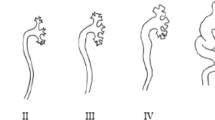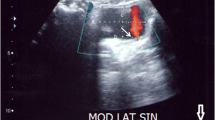Abstract
In recent years, the exact role of vesicoureteric reflux (VUR) in general has become controversial, though in some groups of children the knowledge of the existence or non-existence of VUR is still a very important issue. The number of techniques available for the assessment of VUR is increasing, and a new classification taking into account their real characteristics (direct/indirect, catheter-using/catheter-free, radiation-giving/radiation-free) has been proposed. The purpose of the following review is to evaluate the currently available evidence supporting the use of various catheter-free methods for VUR detection. We believe that as the clinical role of VUR has been questioned, it is even more important for the method of its detection to be user-friendly as regards catheterisation, radiation and availability. There is still no evidence supporting the assertion that any of the catheter-free methods of VUR detection might be the optimal one for any child. However, there are some groups of children who would benefit from using them. New studies using new, catheter-free methods of VUR detection or a combination of two or more of the methods described may prove useful in improving sensitivity and providing additional data on this important issue.
Similar content being viewed by others
References
Venhola M, Uhari M (2009) Vesicoureteral reflux, a benign condition. Pediatr Nephrol 24:223–226
Coulthard MG (2009) Vesicoureteric reflux is not a benign condition. Pediatr Nephrol 24:227–232
Arat BS (1991) Vesicoureteric reflux and renal injury. Am J Kidney Dis 17:491–511
Smellie JM, Normand IC (1975) Bacteriuria, reflux, and renal scarring. Arch Dis Child 50:581–585
Mannhardt W, Schofer O, Schulte-Wissermann H (1986) Pathogenic factors in recurrent urinary tract infections and renal scar formation in children. Eur J Paediatr 145:330–336
O’Donnell B (2004) Reflections on reflux. J Urol 172:1635–1636
Marra G, Oppezzo C, Ardissino G, Dacco V, Testa S, Avolio L, Taiolio E, Sereni F (2004) Severe vesicoureteral reflux and chronic renal failure: a condition peculiar to male gender? Data from the ItalKid Project. J Pediatr 144:677–681
Wheeler D, Vimalachandra D, Hodson EM, Roy LP, Smith G, Craig JC (2003) Antibiotics and surgery for vesicoureteric reflux: a meta-analysis of randomized controlled trials. Arch Dis Child 88:688–694
Craig JC, Irwig LM, Knight JF, Roy LP (2000) Does treatment of vesicoureteric reflux in childhood prevent end-stage renal disease attributable to reflux nephropathy? Pediatrics 105:1236–1241
Moorthy I, Easty M, McHugh K, Ridout D, Biassoni L, Gordon I (2005) The presence of vesicoureteric reflux does not identify a population risk for renal scarring following a first urinary tract infection. Arch Dis Child 90:733–736
Benador D, Benador N, Slosman D, Mermillod B, Girardin E (1997) Are younger children at highest risk of renal sequelae after pyelonephritis? Lancet 4:17–19
Martinell J, Claesson I, Lidin-Janson G, Jodal U (1995) Urinary infection, reflux and renal scarring in females continuously followed for 13–38 years. Pediatr Nephrol 9:131–136
Jacobson SH, Eklof O, Eriksson CG, Lins LE, Tidgren B, Winberg J (1989) Development of hypertension and uraemia after pyelonephritis in childhood: 27 year follow-up. BMJ 299:703–706
El-Khatib MT, Becker GJ, Kincaid-Smith PS (1990) Reflux nephropathy and primary vesicoureteral reflux in adults. Q J Med 77:1241–1253
Gordon I, Barkovics M, Pidoria S, Cole TJ, Woolf AS (2003) Primary vesicoureteric reflux as a predictor of renal damage in children hospitalized with urinary tract infection: a systematic review and meta-analysis. J Am Soc Nephrol 14:739–744
Riccabona M, Avni FE, Blickman JG, Dacher JN, Darge K, Lobo ML, Willi U (2008) Imaging recommendations in paediatric uroradiology: minutes of the ESPR workgroup session on urinary tract infection, fetal hydronephrosis, urinary tract ultrasonography and voiding cystourethrography, Barcelona, Spain, June 2007. Pediatr Radiol 38:138–145
Stefanidis CJ, Siomou E (2007) Imaging strategies for vesicoureteral reflux diagnosis. Pediatr Nephrol 22:937–947
Riccabona M, Fotter R (2004) Urinary tract infection in infants and children: an update with special regard to the changing role of reflux. Eur Radiol 14:L78–L88
Riccabona M (2002) Cystography in infants and children: a critical appraisal of the many forms with special regard to voiding cystourethrography. Eur Radiol 12:2910–2918
Gordon I, Colarinha P, Fettich JJ, Fischer S, Frökier J, Hahn K, Kabasakal L, Mitjavila M, Olivier P, Piepsz A, Porn U, Sixt R, van Velzen J (2001) Guidelines for indirect radionuclide cystography. Eur J Nucl Med 28:BP16–BP20
Evans ED, Meyer JS, Harty MP, Bellah RD (1999) Assessment of increase in renal pelvic size on post-void sonography as predictor of vesicoureteral reflux. Pediatr Radiol 29:291–294
Hiraoka M, Hori C, Tsukahara H, Kasuga K, Ishihara Y, Kotsuji F, Mayumi M (1999) Vesicoureteral reflux in male and female neonates as detected by voiding ultrasonography. Kidney Int 55:1486–1490
Hiraoka M, Kasuga K, Hori C, Sudo M (1994) Ultrasonic indicators of ureteric reflux in the newborn. Lancet 343:519–520
Hiraoka M, Hashimoto G, Hori C, Tsukahara H, Konishi Y, Sudo M (1997) Use of ultrasonography in the detection of ureteric reflux in children suspected of having urinary tract infection. J Clin Ultrasound 25:195–199
Kopač M, Kenig A, Ključevšek D, Kenda RB (2005) Indirect voiding urosonography for detecting vesicoureteral reflux in children. Pediatr Nephrol 20:1285–1287
Marshall JL, Johnson ND, De Campo MP (1990) Vesicoureteric reflux in children: prediction with colour Doppler imaging. Radiology 175:355–358
Nishizawa O, Ishida H, Sugaya K, Kohama T, Harada T, Tsuchida S (1989) Application of Doppler colour flow imaging method on the detection of vesicoureteric reflux. Tohoku J Exp Med 159:163–164
Oak SN, Kulkarni B, Chaubal N (1999) Colour flow Doppler sonography: a reliable alternative to voiding cystourethrogram in the diagnosis of vesicoureteral reflux in children. Urology 53:1211–1214
Salih M, Baltaci S, Kiliç S, Anafarta K, Bedük Y (1994) Colour flow Doppler sonography in the diagnosis of vesicoureteric reflux. Eur Urol 26:93–97
Koşar A, Yeşiladağ A, Oyar O, Perk H, Gǖlsoy U (2003) Detection of vesico-ureteric reflux in children by colour-flow Doppler ultrasonography. BJU Int 91:856–859
Heberlik A (1997) Detection of low-grade vesicoureteric reflux in children by colour Doppler imaging mode. Pediatr Surg Int 12:38–43
Leung VY, Chu W, Yeung CK, Metreweli C (2007) Doppler waveforms of the ureteric jet: an overview and implications for the presence of a functional sphincter at the vesicoureteric junction. Pediatr Radiol 37:417–425
Leung VY, Metreweli C, Yeung CK (2002) The ureteric jet Doppler waveform as an indicator of vesicoureteric sphincter function in adults and children. An observational study. Ultrasound Med Biol 28:865–872
Leung VY, Metreweli C, Yeung CK (2002) Immature ureteric jet Doppler patterns and urinary tract infection and vesicoureteric reflux in children. Ultrasound Med Biol 28:873–878
Ključevšek D, Ključevšek T, Kersnik Levart T, Kenda RB (2009) Ureteric jet Doppler waveform: is it a reliable predictor of vesicoureteric reflux in children? Pediatr Nephrol 24:313–318
Riccabona M, Pilhatsch A, Haberlik A, Ring E (2008) Three-dimensional ultrasonography-based virtual cystoscopy of the pediatric urinary bladder. J Ultrasound Med 27:1453–1459
Author information
Authors and Affiliations
Corresponding author
Rights and permissions
About this article
Cite this article
Ključevšek, D., Ključevšek, T., Kersnik Levart, T. et al. Catheter-free methods for vesicoureteric reflux detection: our experience and a critical appraisal of existing data. Pediatr Nephrol 25, 1201–1206 (2010). https://doi.org/10.1007/s00467-009-1391-7
Received:
Revised:
Accepted:
Published:
Issue Date:
DOI: https://doi.org/10.1007/s00467-009-1391-7




